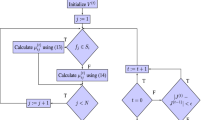Abstract
This paper presents a new generative unsupervised learning algorithm based on a representation of the clusters distribution by histograms. The main idea is to reduce the model complexity through cluster-defined projections of the data on independent axes. The results show that the proposed approach performs efficiently compared with other algorithms. In addition, it is more efficient to generate new instances with the same distribution than the training data.
Access this chapter
Tax calculation will be finalised at checkout
Purchases are for personal use only
Similar content being viewed by others
References
Baldi, P., Brunak, S., Bach, F.: Bioinformatics: The Machine Learning Approach. MIT press, Cambridge (2001)
Benaglia, T., Chauveau, D., Hunter, D.R.: An EM-like algorithm for semi- and nonparametric estimation in multivariate mixtures. J. Comput. Graph. Stat. 18(2), 505–526 (2009)
Bezdek, J.C., Ehrlich, R., Full, W.: FCM: the fuzzy c-means clustering algorithm. Comput. Geosci. 10(2–3), 191–203 (1984)
Cabanes, G., Bennani, Y., Grozavu, N.: Unsupervised learning for analyzing the dynamic behavior of online banking fraud. In: IEEE 13th International Conference on Data Mining, pp. 513–520 (2013)
Dempster, A.P., Laird, N.M., Rubin, D.B.: Maximum likelihood from incomplete data via the EM algorithm. J. Roy. Stat. Soc. B 39(1), 1–38 (1977)
Dudoit, S., Fridlyand, J.: A prediction-based resampling method for estimating the number of clusters in a dataset. Genome Biol. 3(7), 1–21 (2002)
Ester, M., Kriegel, H.P., Sander, J., Xu, X.: A density-based algorithm for discovering clusters in large spatial databases with noise. In: International Conference on Knowledge Discovery and Data Mining, pp. 226–231 (1996)
Hubert, L., Arabie, P.: Comparing partitions. J. Classif. 2(1), 193–218 (1985)
Jain, A.K.: Data clustering: 50 years beyond k-means. Pattern Recogn. Lett. 31(8), 651–666 (2010)
Jebara, T.: Machine Learning: Discriminative and Generative, vol. 755. Springer, Heidelberg (2012)
Maimon, O., Rokach, L.: Data Mining and Knowledge Discovery Handbook. Springer, New York (2005). https://doi.org/10.1007/b107408
McLachlan, G.J., Basford, K.E.: Mixture models: inference and applications to clustering, vol. 84. M. Dekker, New York (1988)
Rastin, P., Cabanes, G., Matei, B., Bennani, Y., Marty, J.M.: A new sparse representation learning of complex data: application to dynamic clustering of web navigation. Pattern Recogn. 91, 291–307 (2019)
Ruschendorf, L.: Wasserstein metric. In: Hazewinkel, H. (ed.) Encyclopedia of Mathematics. Springer, Berlin (2001). https://doi.org/10.1007/978-94-009-5991-0
Strehl, A., Ghosh, J.: Cluster ensembles – a knowledge reuse framework for combining multiple partitions. J. Mach. Learn. Res. 3, 583–617 (2003)
Train, K.E.: Mixed Logit, p. 138–154. Cambridge University Press (2003)
Ultsch, A.: Fundamental Clustering Problems Suite (FCPS) (2005)
Vanschoren, J., van Rijn, J.N., Bischl, B., Torgo, L.: OpenML: networked science in machine learning. SIGKDD Explorations 15(2), 49–60 (2013)
Yue, H.H., Tomoyasu, M.: Weighted principal component analysis and its applications to improve FDC performance. In: IEEE Conference on Decision and Control (CDC), vol. 4, pp. 4262–4267 (2004)
Zhao, H., Fu, Y.: Dual-regularized multi-view outlier detection. In: International Conference on Artificial Intelligence, pp. 4077–4083. AAAI Press (2015)
Acknowledgements
This work was supported in part by the Pro-TEXT project (No ANR-18-CE23-0024) financed by the ANR (Agence Nationale de la Recherche).
Author information
Authors and Affiliations
Corresponding author
Editor information
Editors and Affiliations
Rights and permissions
Copyright information
© 2019 Springer Nature Switzerland AG
About this paper
Cite this paper
Rastin, P., Cabanes, G., Verde, R., Bennani, Y., Couronne, T. (2019). Generative Histogram-Based Model Using Unsupervised Learning. In: Gedeon, T., Wong, K., Lee, M. (eds) Neural Information Processing. ICONIP 2019. Lecture Notes in Computer Science(), vol 11955. Springer, Cham. https://doi.org/10.1007/978-3-030-36718-3_53
Download citation
DOI: https://doi.org/10.1007/978-3-030-36718-3_53
Published:
Publisher Name: Springer, Cham
Print ISBN: 978-3-030-36717-6
Online ISBN: 978-3-030-36718-3
eBook Packages: Computer ScienceComputer Science (R0)




